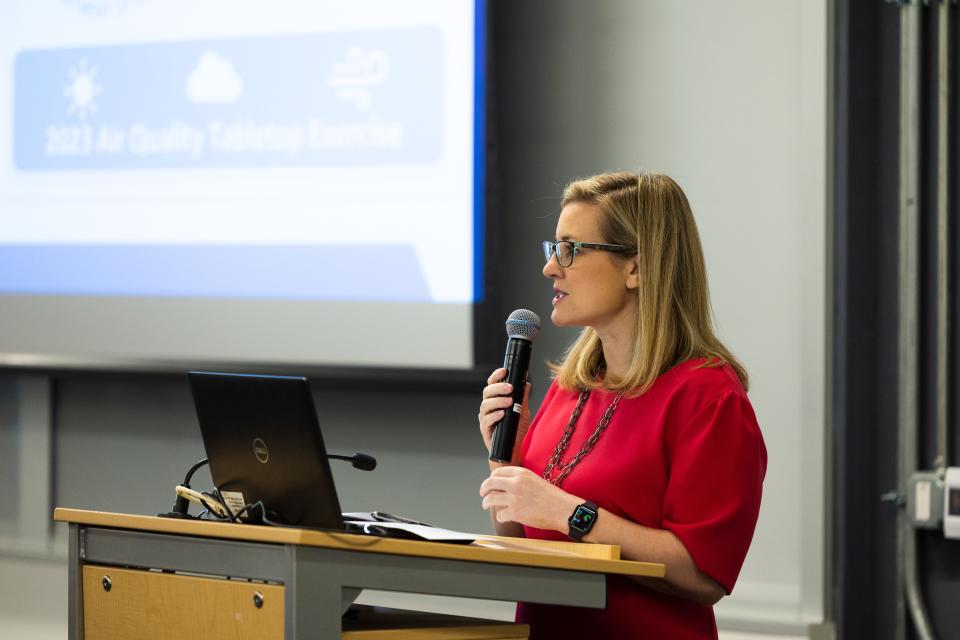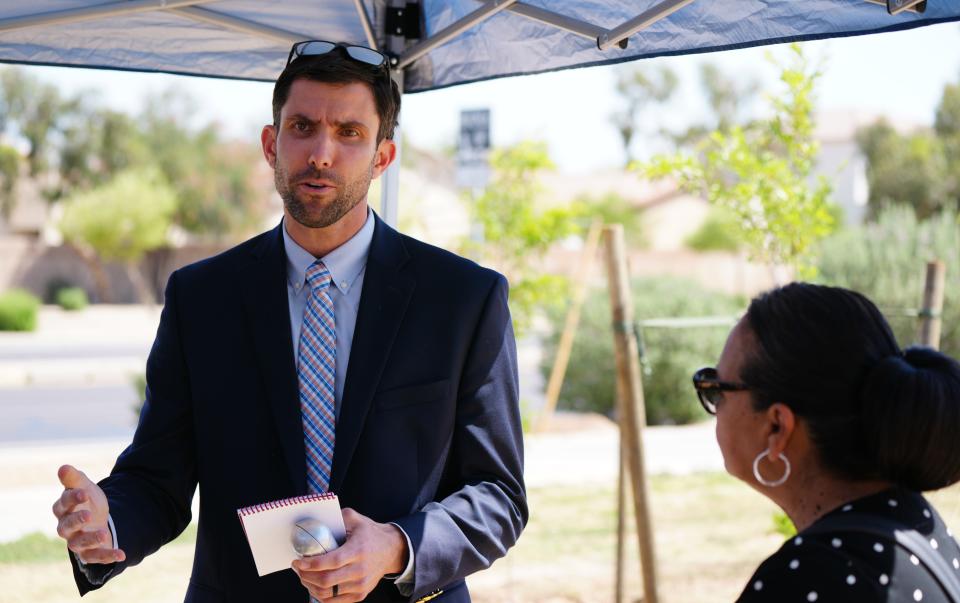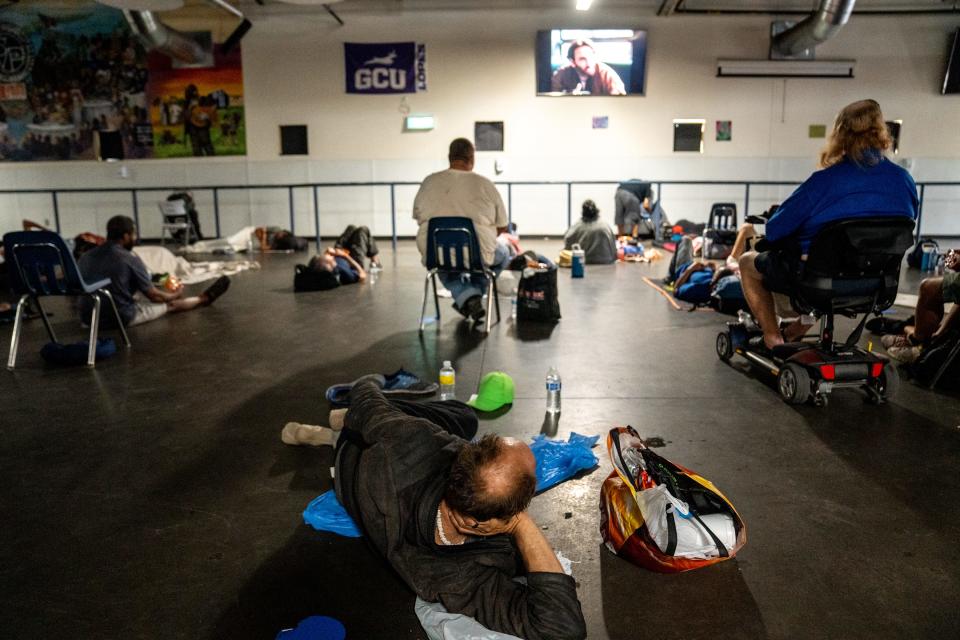Phoenix's heat response draws criticism from advocates. City asks how to improve
Corrections & Clarifications: A previous version of this article misstated how cool pavement affects body temperature. Cool pavement sometimes raises the radiant temperature that a body feels, leading to discomfort.
As Phoenix swelters through a heat wave that breaks records every passing day, community advocates and residents say the city's emergency response efforts are falling short. The city heat director says his team is toiling to meet the moment, but he also acknowledges more needs to be done.
"If there had been a crime spree that resulted in 425 deaths that concentrated on a certain population ... imagine the scale of mobilization we would have to investigate what was happening. We're just not there yet on our heat preparedness," Dave Hondula told a group of reporters in mid-July.
Hondula, appointed as the first Phoenix heat director in 2021, was referencing the number of heat-associated deaths in 2022. It is that metric that his office is trying most ardently to lower.
Under Hondula's direction, the city released a plan in April that outlined 31 tactics to respond to summer heat, including guidance for first responders, opening heat relief centers at city facilities such as libraries and tents in high-need areas like downtown. The plan calls for volunteer programs to hand out water, particularly to the unsheltered and to hikers who brave mountains in immense summer heat.
Another volunteer program is supposed to conduct wellness calls for people who live alone, such as elderly retirees. Failing air conditioning units can be catastrophic for health outcomes, if not outright deadly, and volunteers are supposed to connect those in need with emergency utility assistance.
But advocates passionate about the environment and protecting Phoenix's unhoused population point to what they see as obvious flaws, including:
Heat relief centers close in the afternoon when the temperature is often at its peak.
Tents that provide water but no way to cool people off.
Some parts of Phoenix lack facilities and support.
Some residents have pointed out city practices that seem antithetical to heat safety guidance, such as removing shaded bus stops mid-summer and not immediately replacing them or citing homeowners for failing to maintain their lawns.
"It’s pretty dang counterproductive to tell folks to be mindful of heat safety and also threaten to fine them for not doing yard work," one resident wrote on Twitter.
City spokesperson Brenda Yanez said bus stop shelters are sometimes removed and replaced if they've been damaged by a car accident, for example, but that the city did not otherwise plan to remove shaded stops. She added that "73% of our 4,000 bus stops (are) shaded and we continue to install more."
Teleia Galaviz, spokesperson for the Phoenix Neighborhood Services Department, said the city continues front yard code enforcement during the summer, but "we take hardships into account and provide additional time when needed."
"Code enforcement is intended to be used to foster partnership with residents to support the overall health, safety, and welfare of the city, and to protect neighborhoods against hazardous, blighting, and deteriorating influences or conditions," Galaviz said.
An Arizona Republic review of the city's summer heat response plan found one of the programs has not even gotten off the ground.
A "mobile water unit" designed to transport a tank of refrigerated water to community events and areas in need was supposed to be operational but has not been deployed.
This summer, volunteers have been plentiful, and Hondula said he's confident it's made a serious impact.
The Arizona Republic asked the city about the program's status in mid-June, including where it would go, how the locations were chosen and when its service would begin.
Water Services Department spokesperson Jimena Garrison said "as soon as possible" and that "we do not have a specific deployment plan at this time." The goal, however, would be to service "vulnerable" populations, she said.
A month later, the city had no updates. When asked about whether any progress had been made, the spokesperson said, "It's still being built. We will deploy it as soon as we can."
The tank is supposed to be able to fill 4,400 water bottles at a time — an asset that could aid the city in its stated effort to reduce plastic water bottle use and fill the city's 10,000 aluminum reusable bottles it is handing out. It could also assist in areas where regional heat relief centers are lacking, such as Laveen and parts of Phoenix west of Interstate 17.
Hondula said his team has modified their vehicle to pull the water trailer and is still hopeful it will come online soon.
When confronted with criticism over the city's general heat response, Hondula said he hadn't heard much of the concerns and encouraged residents and organizations to reach out directly.

"We're not hard to find," he said. He added that his team was not created "to maintain the status quo" and welcomed information and ideas from the community. "We can do better," he stressed, but he also pointed out that his team was working "physically hard" day in and day out to make a tangible difference.
"If people want to engage with us and have constructive dialogue about how we can improve city programs, that's why we're here. ... We know all the good ideas are not held just on our little team," Hondula said.
Phoenix Mayor Kate Gallego, in a statement to The Republic, said the summer heat has proven the need for the heat office and showed how important it is that the office’s work continue.
“Phoenix is stepping up to confront the existential challenge of extreme heat, including by establishing the first-of-its-kind Office of Heat Response and Mitigation. The last few weeks alone have proven that our efforts are not only direly needed, but that it is paramount to keep our momentum going. This year, in partnership with community organizations and volunteers, we have expanded our reach to keep residents safe in extreme temperatures. Although the City is not the public health authority for our region, we continue to lead in an area where additional assistance from all levels of government could multiply our impact. I will continue to push for additional solutions and hope more partners will join our movement to address the effects of climate change,” Gallego said.
Megan Kepler, a Phoenix resident, volunteers a few days a week with Feed Phoenix, handing out food and heat relief supplies to people experiencing homelessness. She spends up to $500 a month, she said, on supplies like water bottles and ice.
She tries to use the regional heat relief network website during street outreach hours, but she said it's inadequate because many facilities are closed certain days or in the later afternoon hours when relief is most necessary. Some locations, like libraries, aren't welcoming to unhoused people who appear dirty or have bags with them, Kepler said.

The heat relief network is a regional collaboration managed by the Maricopa Association of Governments, and Phoenix provides more than 60 facilities to the effort — more than any other Valley city, as Phoenix officials are often quick to point out.
Hondula has acknowledged the limited hours of facilities in recent interviews, saying "there are very few places in the heat relief network that have extended availability" and that it was a result of staffing capabilities. But, he said, municipalities and partner organizations were looking into what could be done and noted a few centers were beginning to extend hours.
The hours that facilities are open, traditionally 9 a.m. to 6 p.m. with exceptions, are when 911 call data shows the need is highest, Hondula said. He added that there are always tradeoffs to weigh, but the city tries to make data-informed, strategic decisions to have the most positive effect.
Hondula encouraged people to check out the Brian Garcia Welcome Center on the Human Services Campus downtown.
Kepler said city officials frequently default to the Human Services Campus, creating a situation that clusters people in need in one area. She pointed to the downtown encampment known as "The Zone," where she also conducts outreach, and said many unhoused people don't want to go near there.
With pushback to cool pavement, more focus placed on shade
Other Phoenix residents question the city's long-term heat mitigation strategies.
The city boasted in June about deploying 100 miles of cool pavement. The light-gray colored material absorbs less heat than traditional asphalt, resulting in cooler surface temperature that is, when deployed at scale, supposed to help reduce air temperatures.
But an unintended consequence of the pavement is that it reflects the heat upward and becomes absorbed by those who stand atop it. That makes it uncomfortable for the individual even while it potentially stands to benefit the broader environment at large. A study from Arizona State University said cool pavement, on average, raises radiant heat temperature that a person feels by 5.5 degrees Fahrenheit.
Hondula has acknowledged this reality in recent weeks and tried to emphasize other benefits, such as cool pavement's ability to protect roadways from cracking or experiencing other consequences from heat. He also points out that the increase in body temperature specifically happens when the individual is standing in the middle of the cool paved street, not the adjacent sidewalk.

He said he believed it could still be beneficial in combating the urban heat island effect and reducing electricity bills if deployed at scale. But moments before, the heat director said cool pavement would not be a good heat mitigator in high pedestrian areas or underneath playgrounds for example — raising questions about how realistic the prospect of ubiquitous cool pavement is in Phoenix.
Asked about it a second time, Hondula said there were "thousands of square feet of dark asphalt in the city where there are not concerns about pedestrians" that it could be deployed.
In this summer's media blitz, Hondula has increasingly focused instead on the importance of shade and how it can drastically improve the quality of life for everyday Arizonans even as the air temperature remains high and for long periods.
The heat director has highlighted Phoenix's unprecedented investments in shade installation and urban forestry initiatives, largely funded through federal initiatives and with guidance from the City Council.
The city in May approved a budget with $8.4 million in federal grants that will go toward installing shade. Last month, Phoenix became a finalist in a national $1 million public art challenge by proposing "to commission 12 artists to create shading and cooling installations in response to global warming."

"We've evolved into understanding that the real goal is to have more people who are more comfortable more often in the Phoenix of the future, and that may or may not be manifested in (air temperature)," Hondula said. "If we had much, much more shade coverage in the city, we could have people moving throughout 115-degree days in a much safer and more comfortable way."
But Hondula's comments feel obvious to community advocates who've pushed for more shade for years.
Stacey Champion, a Phoenix resident, said the importance of shade and need for more of it is nothing new. The city should have more seriously prioritized it long ago, even before Hondula arrived in 2021. She said she believes the city pushed cool pavement to garner positive press.
"This was more of a headline ploy for the City of Phoenix to say we lowered the temperature X degrees," Champion said. "Versus focusing on thermal comfort in a city and state where many people are hospitalized and die from heat. People should be at the core of every decision the city makes."
Sam Stone, ex-chief of staff to former Councilmember Sal DiCiccio, points to the city's Tree and Shade Masterplan from 2010. The 62-page plan set a goal to shade a quarter of the city with trees by 2030.
The city has in recent months signaled a pivot away from that plan, saying that they instead want to focus on tree equity, meaning planting trees according to where they're needed most, as opposed to hitting a percentage goal.
"The goal needs to be more nuanced," the heat office's urban tree program manager Lora Martens told The Republic in May. “Certain areas need more tree coverage, so I’m not sure a blanket 25 percent is the right goal to have.”
Environmental inequities: In low-income Phoenix neighborhoods, the lack of shade trees is a question of equity
Hondula, on an episode of The Daily podcast from The New York Times released July 20, said the city "over the past decade has struggled to make progress" planting trees.
He attributed some of it "arguably" to not having a heat office that helps different city departments coordinate. But the main reason, he said, was "site identification." He gave the example of how the Phoenix Streets Department has limited spots along roadways to actually plant trees.
The city's website makes it unclear how far along they are in the goal. As of July 20, the website shows a "Shade Green 2030 Dashboard," but it hyperlinks to a document that lists accomplishments from 2010 and 2011 only. The "City of Phoenix Tree Inventory" hyperlinks to a 404 error webpage.
The way Stone sees it, the city is trying to hide the fact that it's failing on its shade goal from 2010. And since planting trees and deploying cool pavement are tasks that other departments carry out, Stone said he doesn't believe the heat office is worth the money.
"They keep adding layers of bureaucracy to this thing ... We already had departments doing these activities. All of these things were already happening, and now, we've added people to oversee them, which costs money ... and that just reduces the amount they can do," Stone said.
Champion, Kepler and Stone all expressed a feeling that the city was mired in bureaucracy and at least sometimes placed its own public image over the needs of the people.
"I think it's performative in a lot of ways," Kepler said.
Real-time information about city programs' efficacy in short supply
Beyond anecdotes and qualitative observation, it is difficult to know how and whether Phoenix's emergency response programs are adequately responding to the summer's heat challenges thus far.
Heat-related fatality figures from Maricopa County are seen as the gold standard to measuring the city efforts' success by.
So far, the county has seen 18-heat related deaths and is investigating 69 more, down from 29 confirmed deaths and 193 under investigation at this time last year.
But those numbers lag significantly, Hondula has said, making them unreliable methods to determine which or whether real-time adjustments to city programs should be made.
Instead, Hondula's team focuses on mapping 911 heat calls to know how to adjust response efforts. Sometimes the team's plan for where to deploy volunteers and resources changes by the day, depending on what the data shows, he said.
He added that some high-need places last year are not high-need this year, and that the heat team has had to be nimble and constantly adapt.
The city had seen some indication in mid-July that fewer heat-related calls for service were coming in than last year, Hondula said. But still, he said, it's too early to know what role the city's efforts played in that.
For the most visible form of outreach, volunteer programs, the city aimed to enlist 40 volunteers in the "We're Cool" program and 20 in the "Cool Callers," program.
Hondula said the city had well exceeded 40 volunteers for the We're Cool program — so much so that shifts are frequently full. The heat team adds as many shifts as there are staff to manage it, Hondula said, and he thinks openings will free up in August. The heat office also has only one vehicle, he pointed out.
A city spokesperson said the program had so far assisted about 3,700 people through 929 staff and volunteer hours this summer. More than 11,000 items have been distributed, the spokesperson said.
The Cool Callers program, Hondula said, was struggling to draw enrollments. So while volunteers are ready, they don't actually have many people to call.
The heat office is supposed to compile a "weekly status report" focused on "highlights of heat response programs and service implementations, recommendations for program modifications (where warranted) and summaries of available weather and health data," according to the summer heat plan.
The plan does not set a date for when they are supposed to commence. This year, they began in July.
"Our days are very full here. We've tried to prioritize getting the volunteer programs up and running ... doing the impactful, forward-facing work," Hondula said. He added that there was not high demand for the weekly reports in May and June.
The Republic requested the weekly reports in June for between April and mid-June — prior to knowing they did not exist. The city sent different weekly status reports the heat office compiles.
Hondula said it was done in error.
The reports sent to The Republic focused mostly on media engagements, creating regional and national partnerships, summaries of trips to learn about how other cities are mitigating heat, and panels that the city participated in related to heat and climate change. They did not include information about preparation for summer programming.
Hondula said those are the weekly highlights provided to the mayor and City Council on a year-round basis to keep city leadership informed on the office's whereabouts. They stop over the summer when Council is on recess.
The City Council last met July 3 and won't meet again until Aug. 28.
Reporter Taylor Seely covers Phoenix City Hall for The Arizona Republic. Reach her at tseely@arizonarepublic.com, by phone at 480-476-6116 or on Twitter @taylorseely95.
This article originally appeared on Arizona Republic: As residents criticize Phoenix's heat response, city encourages input

